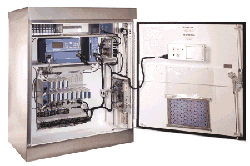How Traffic Signals Work
Traffic lights are usually timed or are traffic responsive. When signals are operated exclusively on timers, each direction is allocated a specific period of ‘green’ time regardless of traffic conditions at any particular time. Signals that are traffic responsive operate using a combination of vehicle sensors/detectors and timers. When the signal is operated in this manner, for example, the light on the main street may stay green at all times unless a vehicle is detected on a side road. Detectors can be used to determine when a car arrives at an intersection, when too many cars are stacked up at an intersection (to control the length of the light), or when cars have entered a turn lane (in order to activate the arrow light). This explains why it seems you have to wait longer for a green light at times and why you may not get a flashing green arrow every time you arrive at a particular intersection. Have you ever wondered how a traffic light “knows” you are there?
How traffic lights detect your presence?
 |
|
The image above shows the inductive loop used in detecting cars |
Many people think that there are sensors in the road that detect the weight of a vehicle stopped on top of them, however that is not often (if ever) the case.
There are all sorts of technologies for detecting cars - everything from lasers and cameras to rubber hoses filled with air.
The most common technique, by far, is the inductive loop. An inductive loop is simply a coil of wire embedded in the road's surface that acts somewhat like a magnet. When a car drives over or stops on the loop, metal in the car changes the magnetic field, the wires detect the change and tell the signal controller that a car is present. In some cases loops are installed entirely beneath the asphalt, and are not visible. In other instances, a groove is cut in the asphalt with a saw, the wire is laid in the groove and sealed with a rubbery compound. You can often see these big rectangular loops cut in the pavement because the compound is obvious.
The signal controller is the ‘brain’ of a signal system. It controls the selection and timing of traffic movements in accordance with varying demands of traffic as determined by the detectors. The controller at one intersection can also communicate with controllers at other intersections and can be programmed to coordinate signals on a timed cycle during peak hours along a particular route in order to maximize the efficiency of directional traffic flows.

The picture to the left shows the signal controller which controls the selection and timing of traffic movements.
Many of the traffic signals throughout the City of St. John’s are operated using detectors and co-ordination. Columbus Drive and the Prince Phillip Parkway are operated in this manner for example. The City usually uses inductive loops as detectors, but there are some intersections where cameras are used as well.
